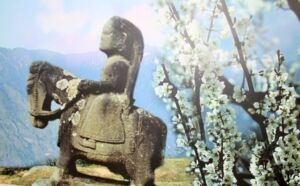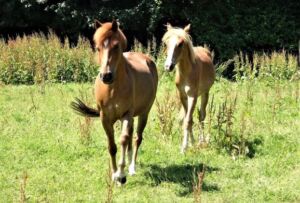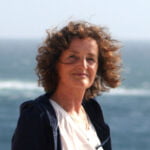In this case the author explores a combination of body work with regression therapy and applies personification[1] and energy work to include animals.
The client:
In April 2015 a client came to me for body training after a hip replacement, which had been done on March 2015. The 51-year-old woman had decided to recover from her operation on the island of Fuerteventura.
She had been born with Perthes disease[2] (Orthoinfo, 2015). She was three years old when the diagnosis was made, and at first, she was not allowed to walk. At age four to five she had to wear an iron shell around the right leg and a five cm high special shoe on the left.
At age seven all seemed OK. At the age of 13 she again had pain and the doctor prohibited further horse riding. Another doctor suggested an operation when she reached 18, to take four centimeters of bone out of the left leg.
From age 40 to the age of 50 she repeatedly went to the osteopath and several therapists. At the age of 50 she couldn’t ride anymore because of too much pain in the right hip. Her profession at that time was working with horses for difficult children.
The training:
I noticed pain and stiffness in her right shoulder. Because the operation had been only five weeks before, I started with light movements according to the Cantienica-Method (The Cantienica Method, 2018). In this method the client stretches and aligns all bones according to the blueprint of the human body, in a way that all muscles, chords, ligaments and fascias regain their basic tone and vividness.
In the following weeks, I worked with her on a mat or in warm water pool. By the time she trusted me, I suggested a regression session on the bodily sensations that came up several times during our training: body parts blocking or feeling divided in two halves.

Image credit: Amora Melchizadek – Shamanic Practitioner
Contact: https://merkabamagic.wixsite.com/mysite
Regression sessions
In the first sessions, we explored situations in her childhood: not being allowed to do things like other children and her resistance against those prohibitions.
Her right leg was always hindering (forbidden), her right shoulder was stiff. My interpretation of what she was telling herself: I always was limited by too many do’s and dont’s. I will do it nevertheless. I love to do forbidden things.
The body had absorbed this resistance. Without this resistance, she felt uncertain in performing movements, not trusting herself. If she focused on where the movement should go, it improved.
In one session she found herself as a five-year-old girl wanting to run down a hill to a pond while her father grabs her arm to prevent her running to it.
In this session I again found energy from other people attaching to the body of the client. During the session, she experienced this as a huge weight. Because I also work with the body of the client in the training, I could feel this heaviness: the weight of two arms in one.
We worked on the relationship between father and daughter. The father is extremely concerned and cares about her. Throughout her life, a strong symbiosis of mutual care of father and daughter had developed.
Therapist: Is that the first time, you care like this for each other?
Client: No.
Therapist: How long has this been the case?
Client: Long time
Therapist: Several lifetimes?
Client: Yes.
After that session the right shoulder was softer and there was less pain. She also had more understanding for her father.
In the next weeks I focused on her hip and legs to improve her ability to walk again.
In a next session we started by connecting and aligning the body. At which time the left leg and left pelvis became heavier and heavier. This was the leg where a piece of bone had been removed. We did a regression.
Therapist: What feeling comes with that heavy leg?
Client: Hopelessness.
Therapist: What else?
Client: Not being allowed to move.
While exploring that feeling, a situation at age 18 emerged. She should have surgery to shorten the left leg, but due to a misunderstanding between the doctors, they just anesthetized her without operating. When she awakes, she is frustrated, cries and feels hopeless, mainly in her left leg and whole hip.
Therapist: Go further back on that feeling of being hopeless, with a heavy leg and hip.
Client: I am about five years old, sitting under the kitchen table and not allowed to move.
We went further back to where this feeling was first experience. She is a native American man about 50 years old, sitting in a prairie in front of a fire, waiting. Because there has been heavy fighting, just a small group of his tribe is left, about 15 people, mainly women, children and elderly. He is the only man left who can go hunt bison. The tribe will be lost without the food. But hunting alone, he only can wait where he expects the herds to pass.
Client: I can not leave. I have to wait.
Therapist: How long do you wait?
Client: Very long, weeks.
Therapist: What do you eat in that time?
Client: Nothing.
Therapist: Are you still waiting there?
Client: Yes. [She cries.]
We make this Indian aware how he died at that place, waiting without eating and drinking. His horse remained with him and died there as well. They had a strong connection.
Therapist: Would there have been any other possibility to resolve this problem of having to hunt alone for food?
Client: Yes, ask my wife for help…
But a proud Indian man does not do that—it never has been done before. She sees the same behavior in the present life, difficulty in asking for help.
We freed that Indian man from his place and spoke with his wife and tribe. The pelvis was encrusted at that place in front of the fire, waiting and not allowed to go.
Than we liberate the five-year-old from being stuck under the table, and the hopeless 18-year-old. In the energy work, she gets back the energy of the cut piece of bone from the left leg, blood, muscles and tissue and we reconnect both legs with the pelvis.
The next session we worked in the sitting position. She noticed that in lifting up one leg and then the other, the heaviness of the right leg was very different from the left.
Therapist: First impression: is this your heaviness or from another?
Client: From another.
Therapist: Whatever heaviness is in that leg is softly floating out and rests aside, on that chair. Your first impression: is it solid, liquid or cloud-like?
Client: Solid. It is a huge block of metal. … It is the metal from my hip replacement!
Therapist: Thank the metal for helping you, that you can walk again. Is it changing?
Client: Yes, a bit smaller
Therapist: Take out the energy of all the people who have touched it: the doctor, the nurse, the factory, the one who sold it. How is it now?
Client: Wow … very small
Therapist: From which area of the world is it coming?
Client: Oh, not from here … from space?
Therapist: May be … so it knows how it is to be without gravity.
Client: (laughs) Oh, yes!
Therapist: Now here we have gravity. But we as humans can do things light as well. Thank the metal piece again that it is helping you to do your light movements. How does that feel?
Client: Very good … and lighter.
Therapist: So, try this movement of the leg again—lighter and softer
Client: Ah, this is a big difference.
The following weeks I did short sessions when needed and we continued the training of the body from time to time. She was now able to walk and even run without pain and she could ride horses again. I was happy to see her be independent. After some months she left the island to go home.

Contact: [email protected]
Horses:
In January 2018, I got a message from the client that she would come to me for one week and do a session because her left shoulder hurt. I was curious—what had happened?
When she arrived, she enthusiastically told me about her new training. She had started to become a horse therapist with the FEEL®[3] (Horse Spirit Connections, n.d.) program. I asked her if maybe the hurting shoulder could come from working with the horse, using a rope? She replied indignantly that everything is done without rope and bridle, just with the free will of the horse, never forcing it.
When she was laying on the mat, I noticed her left shoulder was the firm and pushed forward.
In her training, her instructor had her put cones and wooden poles on the ground in the riding arena. Without forcing and touching, the horse should follow her around those objects.
But the horse did not comply or even turn its head in her direction. Tears came to her eyes when she talked about it. The instructor asked her what was on her mind. She said it was the cones and poles. “And what do you want in life?” he asked her. She talked about her life goals. In that moment, the horse turned towards her and walked with her the entire way along the poles and cones.
However, she was still disappointed and frustrated.
Therapist: Zoom out above that arena and look from a distance at yourself. What do you see?
Client: I am putting the cones and wooden bars and think about where to place them.
Therapist: The cones and wooden bars are…?
Client: Obstacles!
Therapist: You look on the obstacles and the horse does not move. And it moves when …?
Client: Oh my God! When I focus on my way, my goals! (She is crying and laughing at the same time.) It is so easy! So obvious!
We talked about horses and her new training. She had one horse for her future therapy business, and the second horse was more of a gift. She was in a stable to look after a horse to buy, when the owner of the stable showed her one horse that should be euthanized because nobody could touch and ride it anymore. All therapies had failed. So, she took it with her for free. She had started to work with that horse and after half a year it was a bit better, but the two hind legs were still in bad condition.
When horses are so sensitive—would it be possible to work as well on them?
The Sherlock Holmes inside me woke up. I suggested—I had never have done that before, but when these horses should become her therapy horses and partners—maybe we could do something for them? She agreed happily. I asked her to personify the horses on a nice location—her horse pasture. The new horse had the energy of her former owner inside: a tall and widely gesturing woman.
Therapist: How much of that former rider is inside the horse?
Client: About 70-80%. A lot!
We told the horse there was no need to retain this energy, that it could release it.
When did the horse become vulnerable? Standing as a young horse in the pasture, a wild and crazy horse frightens her. In that moment, a cold energy of the wet part of the pasture under her hooves enters in the hind legs. First we released that cold energy, then reintegrated the young foal. At the end, we asked the horses, how should they be cleaned in the future after sessions with clients? One just would shake itself, the other wanted to be brushed afterwards.
Two days later the daughter of my client reported that on a vet appointment with the difficult horse, it had been X-rayed and examined without problem or anesthesia. Some weeks later the client wrote me that both horses had now a different and ‘smooth’ energy
***
This case was a lucky coincidence. I just listened to what the client said and felt and trusted her process. This client was open-minded and curious as I explored backgrounds and origins. I was able to help her to become independent and pain-free in her body again. She understood her struggles in life and transformed them into a foundation for her new work as therapist with horses.
In this case I again found how important it is the deliberate integration of artificial parts such as hip joints when there is no way to avoid it. The client gets a different body balance and gains energy.
I did this as well in other cases: with titanium pins in bones, screws and even dental implants. In 2016, in Germany only, there were more than 232,000 hip replacement operations. The number of artificial body parts is increasing. Regression sessions on this topic can help clients greatly because implants have a huge impact on the body system.
I am still not sure which aspect of the body is holding all this information of injuries and blockages from the present life and from past lives. It seems some kind of ‘authority’ connected with the fascia web in the body—to let the information pop up right in the moment when it can be processed. And the body never lies!
The body is present in all our sessions and when we as therapists allow it to express its inherent wisdom, it is a wonderful partner.
As therapists we talk about how to get back the integral view of the body (and the world) as a whole, but usually we treat them as independent aspects. We need to act integrally.
I was in the lucky position to be able to work with this client in the body training and the regression therapy—but I am sure that without the regression work the results would not have been the same. For me it is one of the most important and useful tools to open doors for clients who want to take responsibility and develop themselves further.
I think we regression therapists are sometimes like a conductor of an orchestra. We may not be able to play all instruments, but listening, hearing and understanding their special sound, we may let each of them perform in the right moment, hearing the music as a whole.
References
Cantienica Method, The, (2018). The perfect introduction. Retrieved from https://www.cantienica-method.com/blog/the-perfect-introduction-to-the-cantienica-method
Horse Spirit Connections. (n.d.) FEEL: Bringing the insightful teachings. Retrieved from https://horsespiritconnections.com
Orthoinfo. (2015). Perthes disease. Retrieved from https://orthoinfo.aaos.org/en/diseases–conditions/perthes-disease/
TenDam, H. (2014). Deep healing and transformation: A manual of transpersonal regression therapy. Utrecht, Netherlands: Tasso Publishing.
1 Ed. note. This is done through personification as developed by Hans TenDam. He defines the process as, “Therapy that evokes parts of ourselves appearing as separate individuals. Personifications are parts of ourselves, that more or less lead their own lives… In personification, personal parts and outside influences are visualized as separate persons, that can be addressed, interacted with, healed and either released or integrated.” (TenDam, 2014, p. 401)
[2] Perthes disease is a rare childhood condition that affects the hip. It occurs when the blood supply to the rounded head of the femur (thighbone) is temporarily disrupted. Without an adequate blood supply, the bone cells die, a process called avascular necrosis.
Perthes is a complex process that can last several years. The weakened bone of the head of the femur (the “ball” of the “ball-and-socket” joint of the hip) gradually breaks apart. Over time, the blood supply to the head of the femur returns and the bone grows back.
Perthes disease—also known as Legg-Calve-Perthes—typically occurs in children between 4 and 10 years old. It is five times more common in boys than in girls. However, it is more likely to cause extensive damage to the bone in girls. In 10% to 15% of cases, both hips are affected. The cause of Perthes disease is not known.
[3] FEEL (Facilitated Equine Experiential Learning)®. This approach wants to facilitate the reconnection of heart and soul inspiring healing and growth. It is a modality which involves the horses’ willing participation in assisting people to discover their potential.

